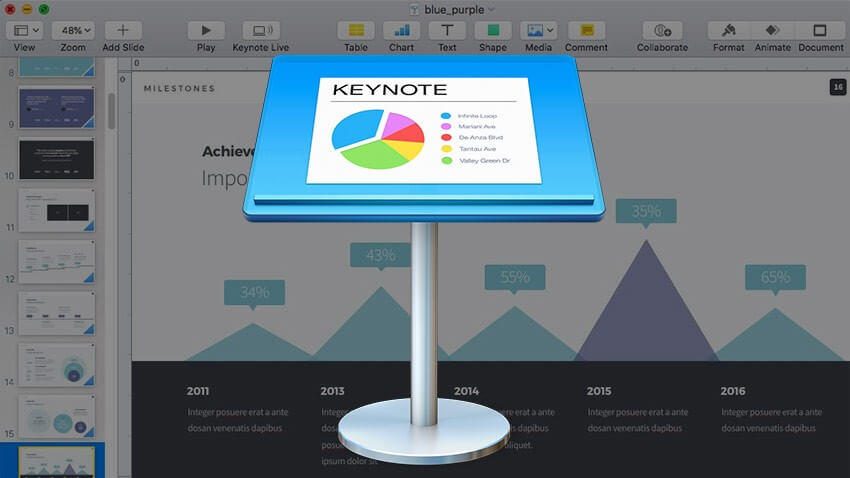Keynote, a simple yet beautiful Apple utility that functions similarly to Microsoft PowerPoint, is designed to create sideshows. It makes your presentation easily understood and more creative. But when creating or editing a Keynote file, there may arise a problem – we may accidentally delete or leave a Keynote Presentation unsaved on Mac, what to do?
No worries, here we list 5 ways to recover unsaved Keynote presentations or restore accidentally deleted/lost Keynote files easily, also include some tips you need to know about Keynote recovery.
Get to Know the Basics about Keynote AutoSave
1. What is AutoSave?
Auto-Save helps to save files on Mac automatically, it is applicable for all document-based apps, such as iWork Keynote, Pages, Numbers, Preview, TextEdit, etc. It is a part of macOS, instead of a standalone program that comes with macOS, also there is quite a little information about Auto-Save revealed by Apple.
2. Does Keynote AutoSave?
Yes, Keynote AutoSave is ON by default and automatically saves the new versions of your file every 5 minutes.
3. Where is Keynote AutoSave Location?
You can find the autosaved Keynote file by visiting this location:
~/Library/Containers/com.apple.iWork.Keynote/Data/Library/Autosave Information
4. Reasons That Caused Keynote Not Saved
When the Keynote app is launched, the AutoSave feature is also enabled by default, but if your Keynote file won’t save on Mac, you can refer to the following reasons and find your solutions to restore the AutoSave feature:
- AutoSave is accidentally turned off. You need to turn it on again.
- Keynote is not updated to the latest version. Check for updates and upgrade to the new edition.
- macOS is not updated to the latest version and causes compatibility issues. Go to AppStore and install the latest macOS version.
- The Keynote file is locked and prevents editing. You need to unlock the file first.
- The Keynote file is corrupted. Find the original copy for editing.
5. Can I Turn Off Keynote AutoSave?
By default, Auto-Save is turned ON, but users can choose not to use this feature by turning it off as follows:
- Go to Apple Menu > System Preferences.

- Choose “General”, you can check or un-check the box before “Ask to keep changes when closing documents” to turn OFF or turn ON the Auto-Save feature.

How to Recover Unsaved Keynote Presentation?
If you are working with a Keynote file on a Mac, it is unlikely that you will leave Keynote unsaved since the Auto-Save feature is always working behind to save your files whenever there is a change done to the file.
But in case your Keynote is quit without saving, here are 2 ways to recover the Keynote presentation that wasn’t saved.
Recover Unsaved Keynote from AutoSave Folder
As we mentioned above, Auto-Save is enabled by default on a Mac to save files automatically. Therefore, we can use Keynote AutoSave to recover unsaved Keynote presentations after crashes or for other reasons.
Steps to Recover Unsaved Keynote Presentation with AutoSave
- Open Finder.
- Go to “Go” > “Go to Folder” and enter the AutoSave folder location: ~/Library/Containers/com.apple.iWork.Keynote/Data/Library/Autosave Information, then click “Go”.

- Now find the unsaved Keynote presentations, open them with iWork Keynote, and save them.
Recover Unsaved Keynote from Temporary Folder
- Go to Finder > Applications > Utilities.
- Launch Terminal on your Mac.
- Input “open $TMPDIR” to Terminal, then press “Enter”.
- Now find the Keynote presentations in the folder, open and save them.

How to Recover Deleted or Lost Keynote Files on Mac?
To recover deleted or lost Keynote presentations, here are 3 ways for your option, you can choose to do the Keynote recovery with or without software, with paid or free service.
Easiest Way to Recover Deleted or Lost Keynote
Ways to recover Keynote files are multiple, but the easiest and most efficient way is using an expert to do the job.
While MacDeed Data Recovery is a good choice. It is a Mac program helping users to recover iWork Pages, Keynote, Numbers, Microsoft Office files, photos, videos, and other files from an internal or external device. With 5 recovery modes, MacDeed Data Recovery can smartly dig out the lost files and restore them successfully.
Main Features of MacDeed Data Recovery
- Support to recover deleted, formatted, and lost files
- Recover photos, audio, videos, documents, archives, and others
- Recover files from Hard Drives, USB Drives, SD Card, Digital Cameras, Mobile Phones, MP3/MP4 Players, iPods, etc
- Apply both quick and deep scan
- Fast scanning
- High recovery rate
- High compatibility on MacOS 13, 12, 11, 10.15, 10.14,10.13, 10.12, or earlier
How to Recover Deleted or Lost Keynote Presentations on Mac?
Step 1. Free download MacDeed Data Recovery, install, and launch.
Step 2. Choose the location.
Go to Disk Data Recovery, and choose the location where you want to recover deleted or lost Keynote files.
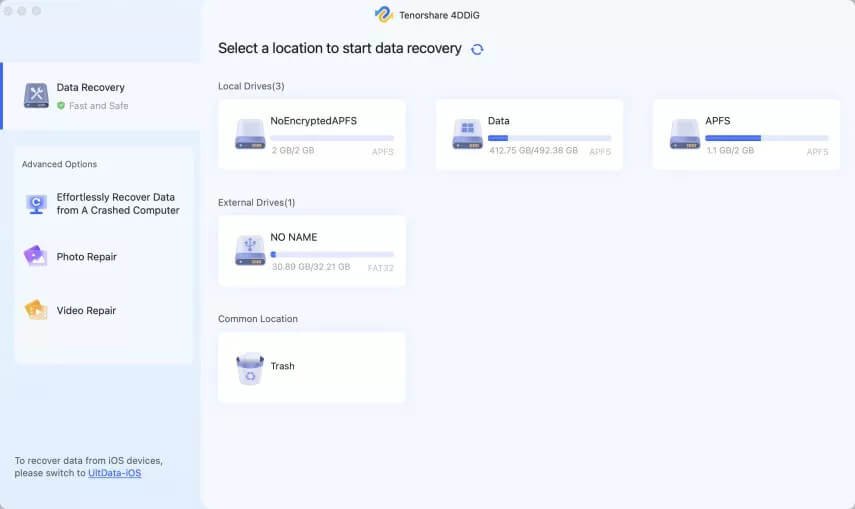
Step 3. Click on the Scan button to locate Keynote files. Go to All Files > Document > Key, or you can enter a keyword to search.
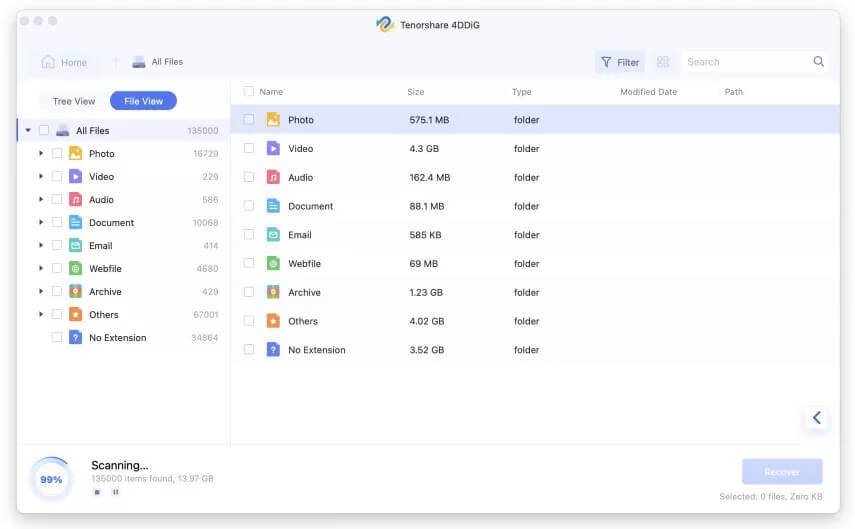
Step 4. Preview and recover the deleted or lost Keynote document.
Double-click on the Keynote file to preview, select, and click on Recover to get it back.
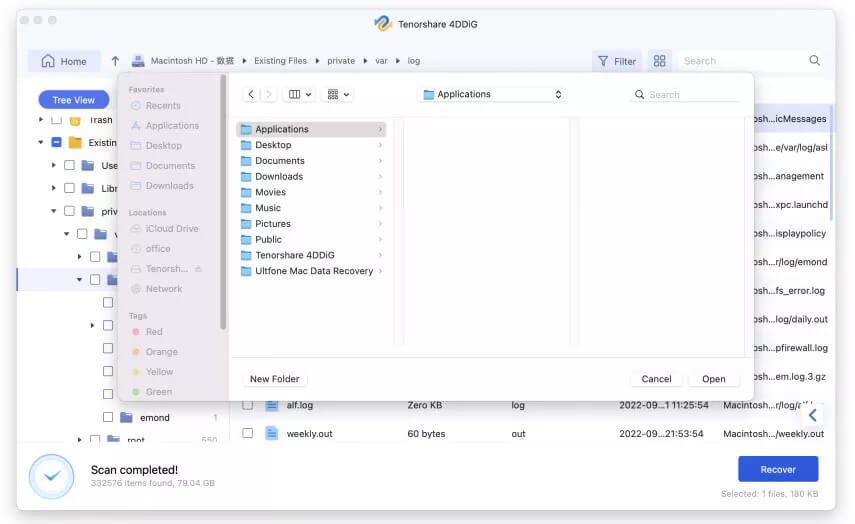
Recover Deleted Keynote Files from Trash Bin
When we delete files on Mac, we just move the files to the Trash bin, they are not permanently deleted, we can still recover the files from the Trash Bin.
Step 1. Go to the Trash Bin.
Step 2. Find the deleted Keynote files. To quickly find the deleted files, you can click on the icon “change the item arrangement” to put deleted files in your preferred order.
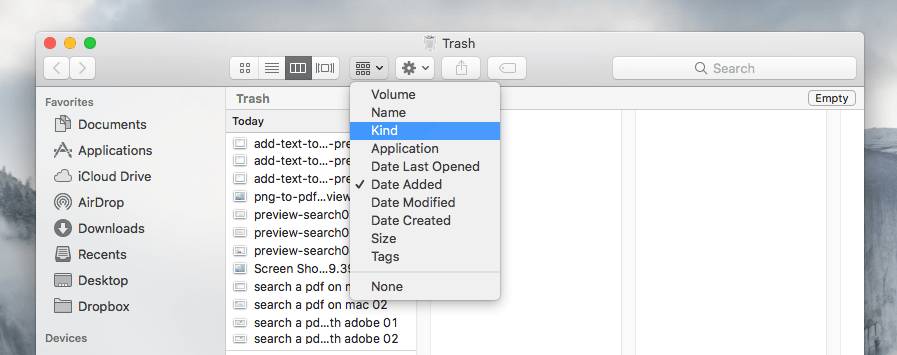
Step 3. Put back the deleted Keynote files. Right-click on the deleted Keynote file and choose “Put Back”.

Step 4. Check the recovered Keynote file. Once you have put the Keynote file back, the folder where your deleted Keynote was originally saved will be opened, and you can now work on the Keynote file.
Recover Deleted or Lost Keynote Files with Time Machine
Yet, if you have permanently deleted the Keynote File and want to recover deleted or lost Keynote files for free, you can use Mac Time Machine.
As we all know, Time Machine is a Mac utility that helps users back up files from Mac to a hard drive, if you have turned Time Machine ON, you will be able to recover lost or deleted Keynote files from Time Machine backup.
Step 1. Go to Finder > Application and launch Time Machine.
Step 2. Open the folder where you store the Keynote file. Or you can go to Finder > All My Files, then find the Keynote file by choosing an arrangement type.
Step 3. Find the Keynote document to recover. You can use the timeline on the edge of the screen to check Word documents backup, then select and press Space Bar to preview.
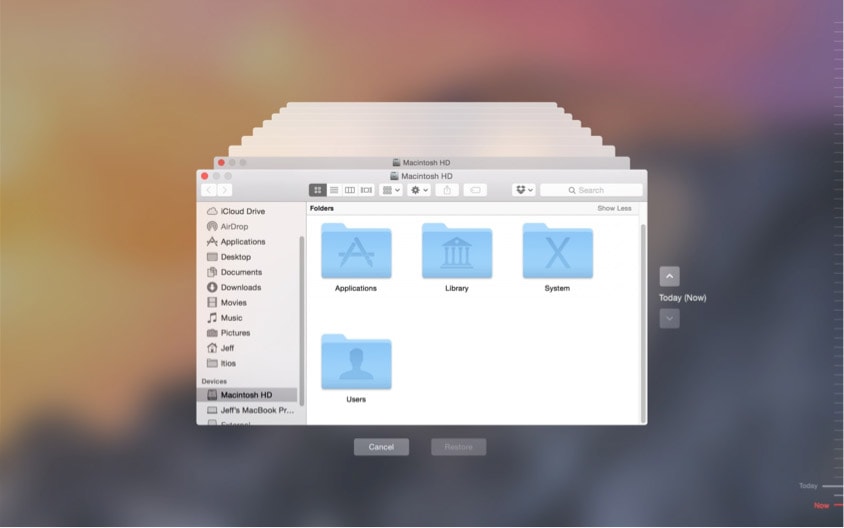
Step 4. Click “Restore” to recover the deleted Keynote file from the Time Machine backup.
Extended: Recover Previous Version or Damaged Keynote
How to Recover Keynote Previous Version?
There are 2 great services MacOS offers to enhance the convenience of working with documents: Auto-Save and Versions. Auto-Save helps to save any change of a document immediately after a change is done to the file; while Versions offers a way to access and compare all previous versions of a document. Basically, on any Mac, the Auto-Save and Versions feature is ON by default.
So, if you want to recover a Keynote previous version, use the Versions feature:
Step 1. Open the Keynote presentation.
Step 2. Go to File > Revert To > Browse All Versions.
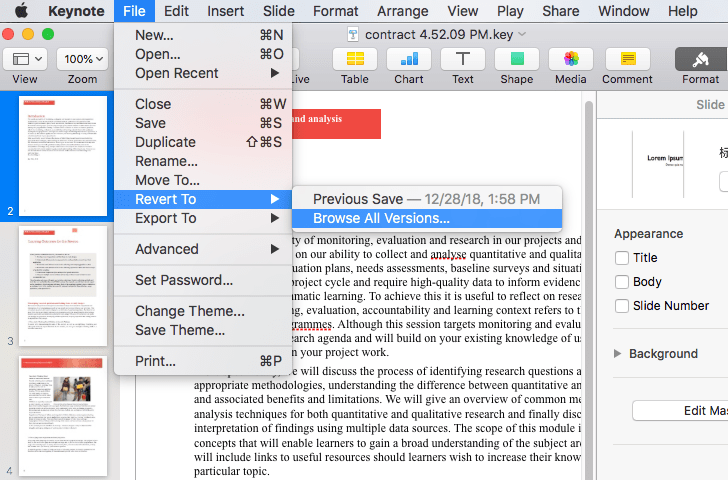
Step 3. Click on the Up and Down icon to choose your preferred version, then click “Restore” to recover Keynote’s previous version.

How to Recover Damaged Keynote?
I just finished a 60-slide keynote, then I tried to open it on my iPhone to practice. The macOS keynote says “The file is damaged and can’t be opened.”—Raphshu from Apple Discussion
Yet, there are sometimes we will run into a similar problem, the Keynote presentation is damaged and cannot be opened. In this case, there are 4 solutions.
Solution 1. Send the Keynote file to a friend that using a different Keynote version, and check if the file can be opened, if yes, you’d better switch to a workable Keynote version on your Mac.
Solution 2. Use the backup. You may have backed up the file via Time Machine or iCloud service, use these services to find your last updated Keynote presentations.
Solution 3. Open the file with Mac Preview, then copy and paste the contents to a new Keynote file.
Solution 4. Convert Keynote to PDF with online free service. The file will be saved in PDF format and you can open the file with Mac Preview. If necessary, copy and paste the PDF contents to a new Keynote file.
Solution 5. Use a piece of Data Recovery software such as MacDeed Data Recovery, to find and get your Keynote file back.
Conclusion
Speaking of recovering Keynote presentations, no matter if it is unsaved, deleted, lost even damaged, we have several possible ways to get it solved. But the best (easiest and most efficient) way is always getting you an expert, let’s say, a Mac Data Recovery Software.
Quickly Recover Keynote Files in 3 Steps – MacDeed Data Recovery
- Recover permanently deleted, lost, and formatted Keynote files
- Restore 200+ file types: docs (Keynote, Pages, Numbers…), images, videos, audios, archives, etc.
- Support data recovery from both internal and external hard drives
- Use both quick and deep scanning to find the most lost files
- Preview files before recovery
- Filter to restore wanted files only
- Recover files to a local drive or Cloud

